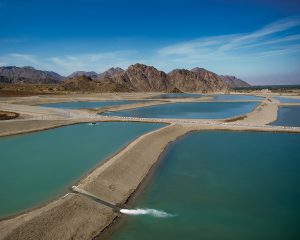
The Coachella Valley’s annual average of 3 inches of rain along with snowmelt from surrounding mountains is not nearly enough for the aquifer groundwater replenishment. Consequently, the Coachella Valley aquifer groundwater basin is in overdraft; we currently pump out more from the aquifer than we percolate back in.
To alleviate groundwater overdraft, Coachella Valley Water District and Desert Water Agency oversee three groundwater replenishment facilities. Artificial replenishment, or recharge, is one of the most effective methods available for preserving aquifer groundwater supplies, reversing aquifer overdraft and meeting demand by domestic and commercial water consumers.
In 1973, CVWD and Desert Water Agency began using their combined entitlements to the State Water Project to replenish the western Coachella Valley aquifer at the Whitewater Spreading Area, northwest of Palm Springs. Today, modern facilities divert storm water, natural runoff from nearby mountains and water released from the Colorado Aqueduct into the riverbed.
In 1994, CVWD began extensive scientific modeling and a pilot groundwater replenishment program in the eastern Coachella Valley. When the program was signed in 2003 by CVWD, Imperial Irrigation District, the Metropolitan Water District and the San Diego County Water Authority, one result was the district could now access an additional 35,000 acre-feet of Colorado River water via the Coachella Canal and apply it to groundwater replenishment among other uses.
CVWD and DWA’s aquifer groundwater replenishment program has percolated 650 billion gallons of water back into the aquifer to date. This has been possible thanks to a supply of imported water from the Sacramento Bay Delta and the Colorado River, as well as entitlements to captured snow melt from the San Gorgonio Mountains.
